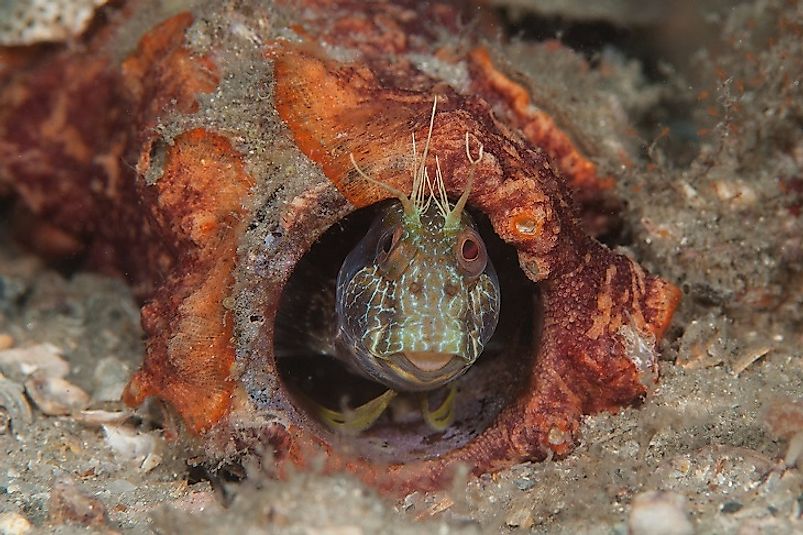Native Fish Species Of Brazil

Brazil is the largest country in South America, covering an area of 3,287,357 square miles. Of this area, 21,411 square miles consist of water. This large area of water includes the Amazon River, 6 other major rivers, and various lakes, which can be found across the country. Additionally, Brazil has a long Atlantic coastline. These numerous habitats are home to a wide number of fish species. Below is a look at some of the native fish species of Brazil.
Native Fish Species of Brazil
Silvertip Tetra
The silvertip tetra lives in the blackwater river habitats of Brazil. These habitats are deep, slow moving rivers that run through swamps and wetlands. The male is characterized by its copper color, whereas the female has a silver color. Both sexes have a transparent appearance, and this species is named for the whitish-silver tips on its fins. Its diet consists of vegetation and small worms.
Band Cusk Eel
The band cusk eel is a saltwater fish that can be found both immediately off the shore of Brazil and further out into the Atlantic Ocean. Its range extends as far north as North Carolina in the United States. This fish species has an elongated appearance and silver color. Its can grow up to 11.8 inches in length and has very short fins that do not protrude from its body. This long, almost finless appearance, may have attributed to its name “eel”.
Zebra Pleco
The zebra pleco is a freshwater fish that is endemic to the Xingu River in Brazil. It can grow up to 2.5 inches in length and is easily recognized by its black and white stripes, which led to its name. This fish species is interesting in that after the female lays fertilized eggs, the male stays with them until they hatch. Once the eggs hatch, the young are able to swim after a week. The zebra pleco was once exported in large numbers for the pet trade industry, but the government has since prohibited its export.
Seaweed Blenny
The seaweed blenny is a saltwater fish that lives in the coral reefs of the Atlantic Ocean. It can be found off the coast of southern Brazil, as far north as New York in the US, and everywhere in between. It can also be found in seagrass, limestone rocks, and oyster beds, where the water is shallow. The seaweed blenny grows to a length of approximately 3.3 inches and has a slim body and beak-like mouth. This fish species presents a wide range of colors, from green to gold and rust to dark brown. Its diet consists primarily of algae, but it also consumes worms and crustaceans. During breeding season, several females may belong to one male. The females lay all of their eggs in a communal nest, which the male watches over until the eggs hatch.
Additional native fish of Brazil can be found in the list below.
Environmental Threats to Brazil's Fish
Despite being a biologically diverse country with a variety of plant and animal habitats, Brazil does face some very serious environmental threats. Agriculture has led to an increased practice in deforestation, which, in turn, has caused higher levels of erosion. This erosion often runs off into the waterways, causing clouding and killing off plants that fish need for survival. The country also experiences acid rain, a phenomenon that changes the pH balance of the soil and waterways where it falls. The increased levels of sulfur dioxide and nitrogen oxide are dangerous to life in water habitats. Additionally, and more specifically, the zebra pleco is at danger because of development of a dam on the Xingu river. This dam will decrease the water flow through the zebra pleco’s habitat. Because it is endemic to this river, the results could be catastrophic for the species.
Native Fish Species Of Brazil
| Native Fish of Brazil | Scientific Name |
|---|---|
| Silvertip Tetra | Hasemania nana |
| Band Cusk-Eel | Ophidion holbrookii |
| Zebra Pleco | Hypancistrus zebra |
| Seaweed Blenny | Parablennius marmoreus |
| Electric Eel | Electrophorus electricus |
| Xingu River Ray | Potamotrygon leopoldi |
| Neon Tetra | Paracheirodon innesi |
| One-Fin Skate | Gurgesiella dorsalifera |
| Arraia Raspy River Stingray | Potamotrygon scobina |
| Western Luminous Roughy | Aulotrachichthys argyrophanus |







